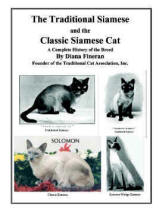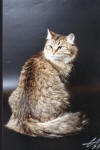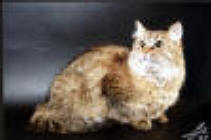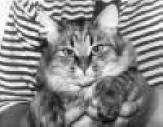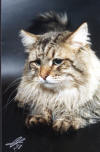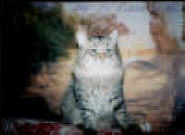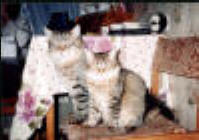Siberian Forest Cat History
© July 2006 - Diana Fineran & Marion Susan Majdiak
|
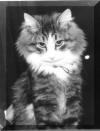 |
Photos Courtesy of the
Siberian Forest Cat Group
in Russia
Click on Photos to Enlarge |
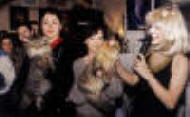 |
History
The Siberian Forest Cat (AKA Siberian Cat) is the national
cat of Russia. It is an aboriginal breed with unknown origin. This natural breed
has existed there for hundreds, if not thousands of years. There is documented
history of Siberian as early as the year 1000. It is a cat from which many fairy
tales have been derived. The Siberian cat is an ancient medium-long haired breed
believed to be the ancestor from which all modern day long-haired cats have
evolved. After living in the cold Russian climate for many generations, over
time it has developed a hardy constitution. In order to survive harsh conditions
it developed a dense triple fur coat that is water resistant. Siberians are not
true shedders, nor does their fur mat easily. Siberians are a muscular cat that
like high places and are powerful leapers. Having a sharp wit along with
their robust athletic bodies enable them to be good hunters. Their natural
beauty, gentle nature and being excellent mousers helped them to become popular
in Russia. People would take their Siberian Cats with them when they moved. This
helped to spread the breed throughout Asia.
The first cat show in the USSR was in 1987. At this show
among the expected cat breeds was the Siberian! Some brave enthusiasts stepped
forward to prove that those animals are worthy of respect and love. After that
show, clubs started to form, other exhibitions started to take place and experts
were invited.
As early as the 1990's there were already set standards for
Siberian breed. They had determined precise differences of the this new breed
from Norwegians and Maine Coons. They laid the fundament of breeding, breeding
with other races is prohibited, important characteristics of the exterior of the
breed are noted in the standard. Forbidding out crossing was to keep the breed
natural and uncultivated by man. The Siberians received nominations; the press
was writing about them, catching the attentions of new people thus
creating interest in the breed world wide. Popularity for the breed sky
rocketed and almost half of the cats represented in the shows were Siberians!
“Neva-Masquerade” is the colorpoint Siberian. Given a
festive name due to the more decorative coats. The Neva originates in Leningrad
(now St. Petersburg) and along the Neva River. When other cats breeds were
imported to this area the Siberian was mixed with pointed cats such as Balinese,
Siamese, Persians, Himalayans, etc., this created offspring with a – fluffy coat
with pointed color. Some claim this mix was natural, why others claim
intentional.
In 1990 Elizabeth Terrell from "Starpoint Cattery"
of Baton Rouge, Louisiana, was the first person to import Siberian Cats into
America. Three Siberian kittens were sent to her as part of a cultural exchange
program between Terrell and Nellie Sachuk, a member of Leningrad's Kotofei cat
club.
David Boehm of Hackensack, New Jersey, was the second
person to Import Siberian Cats into America. Around the same time the first 3
Siberians arrived at Starpoint Cattery, Boehn had flown to Russia and returned
with 15 Siberians. He was the second to import the cats, but he the first to
have Siberian kittens born on American soil. The kittens were delivered at 6:45
a.m. on Wednesday October 10 by a black female named Mary, purchased, from a
member of Moscow's Fauna cat club.
At that time there were two cat clubs in the Soviet Union,
that issued registration papers for Siberian cats: the Fauna club in Moscow and
the Kotofei club in Leningrad.
On February 28, 1997, a seal lynx point with white male
kitten and a seal tortie point female kitten from St Petersburg, Russia, were
imported by Dana Osburn of Wilowbrook Siberians in California. They are the
first colorpoint Siberians to come to the United States.
The Siberian Cat has come a long way, they are found around
the world and have achieved championship status in all major cat registries.
Personality:
Siberian cats have gentle, loving nature and well rounded
personality. They adore children, readily accept the other household pets
and get along great with the whole family. Giving them the ability to blend in
and adapt to almost any family situation.
Siberians have a Dog-like devotion and personality. They
are referred to as "the cat for dog people". Siberians enjoy being with their
human companions. It is not in their nature to be a standoffish or aloof with
their families. Coming when called, following the household members around and
some more social cats even greet guests. Because they are a social cat, if left
alone too often they can become quite lonely. An animal companion, such as
another cat or a friendly dog can help relieve the loneliness and curb
undesirable activities.
It is a slow to develop breed, retaining their kitten
personalities their whole life. Possessing a hardy constitution with no known
genetic defects. They like high places and are powerful leapers. Their sharp wit
and muscular bodies enable them to be good hunters and excellent mousers. They
can be easily trained to do simple tricks such as how to stay off tables,
off counters, play fetch, and be leash trained. Without regular physical and
mental stimulus they can become bored and mischievous.
If not given cause to fear water, they love fresh running
water and will drink from a running faucet, preferring it to drinking out of a
water bowl. Occasionally not only supervising your bath or shower, but actually
joining you.
General:
In order to survive harsh conditions it developed a triple
fur coat that is water resistant. Siberians are not true shedders, nor does
their fur mat easily. Because they don't readily shed, they will drop their
coats twice yearly at the season change. They do not require extensive grooming,
an occasional brushing 1-2 times weekly is sufficient.
They have a soft voice, known as the big cats with the tiny
voice.
Health:
No known genetic defects.
|

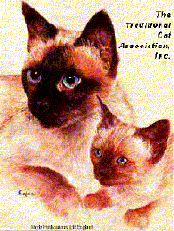 The
Traditional Cat Association,
Inc.©1987®TM
Official Website
The
Traditional Cat Association,
Inc.©1987®TM
Official Website